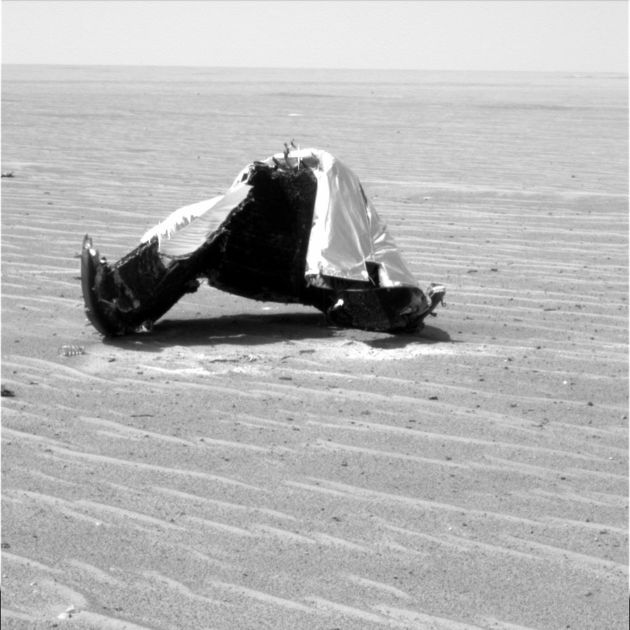Mars Rover Inspects Its Own Debris

NASA's Opportunity Mars Exploration Rover is wheeling about a field of spacecraft litter -- the remains of heat shield hardware that protected the robot from its plunge through the martian atmosphere last January.
Bits and pieces of flotsam scattered across Meridiani Planum -- including a spring and other junked components -- can be clearly seen in new rover images
The heat shield was shed during Opportunity's descent and landing sequence, falling several miles to the surface.
Space engineers are eager to study the clutter for clues as to how well the heat shield survived its fiery entry. Scientists hope to glean useful data about Mars' soil, given the entry shield's high-speed impact.
Free-falling
The Mars Exploration Rover (MER) survey of spent entry equipment includes looking for any surface disturbance produced when the hardware slammed into the terrain.
An entry shield-created crater might give an idea of the mechanical properties of the soil on Mars, said Benton Clark, Chief Scientist of Space Exploration Systems at Lockheed Martin Space Systems in Denver, Colorado.
Breaking space news, the latest updates on rocket launches, skywatching events and more!
Clark, a MER science team member, said that such a crater could help identify and "calibrate" other small craters that the rover comes across.
The heat shield hit hard after it was intentionally dropped off while the Opportunity rover and other landing gear were still on a parachute.
"One of the reasons the scientists are interested in inspecting the area is that they are hoping that when the heat shield hit the ground, after free-falling, it would create a small, fresh crater that we could inspect," Clark told SPACE.com.
On images relayed from Opportunity, there appears to be the impact or a bounce location to the far right of the heat shield, Clark noted.
- Mars Rover Special Report
- On Mars: Earth-Like Clouds and a New Type of Rock
- Marsquakes: Red Planet May Still Rumble

Leonard David is an award-winning space journalist who has been reporting on space activities for more than 50 years. Currently writing as Space.com's Space Insider Columnist among his other projects, Leonard has authored numerous books on space exploration, Mars missions and more, with his latest being "Moon Rush: The New Space Race" published in 2019 by National Geographic. He also wrote "Mars: Our Future on the Red Planet" released in 2016 by National Geographic. Leonard has served as a correspondent for SpaceNews, Scientific American and Aerospace America for the AIAA. He has received many awards, including the first Ordway Award for Sustained Excellence in Spaceflight History in 2015 at the AAS Wernher von Braun Memorial Symposium. You can find out Leonard's latest project at his website and on Twitter.
